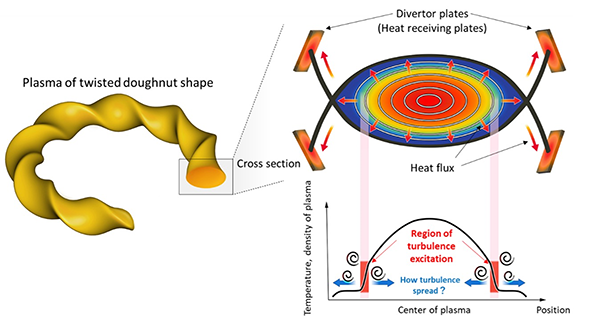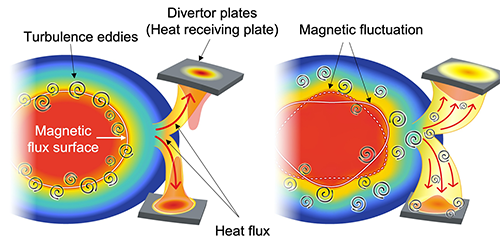Plasma turbulence spreading by magnetic fluctuation reduces heat load on a fusion device wall
2022.3.30 Research Results (Press Release)A research group led by Associate Professor Masahiro Kobayashi of the National Institute for Fusion Science (NIFS) has discovered that in the Large Helical Device (LHD), when fluctuations are generated in the magnetic field confining the plasma, turbulence in the plasma propagates and the heat load on the inner walls of the device is significantly reduced. This has demonstrated new possibilities for controlling turbulence and heat load.
Their results were published on March 23 in Physical Review Letters.
To achieve fusion power generation, it is necessary to confine the plasma in a magnetic field and keep the central temperature of the plasma above 100 million degrees Celsius. On the other hand, to reduce the heat load on the inner walls of the device, the temperature of the plasma near the walls must be kept as low as possible. The temperature gradient of this plasma is extremely large, several million degrees per centimeter. Such a large gradient makes turbulence, which is a flow with eddies, more likely to occur in the plasma (Fig. 1). The turbulence stirs up the plasma, causing the confined heat to escape more easily and lowering the central temperature of the plasma. Therefore, how to control the heat load and the turbulence is the key to achieving fusion power generation.
To control turbulence, it is necessary to clarify how turbulence generated in the plasma propagates. However, the propagation of turbulence is still largely unknown. In addition, to reduce the heat load on the inner walls of the device, a method of cooling the plasma near the walls by introducing impurities has been studied. But this method has many problems, such as the fact that the plasma in the center may also be cooled. New methods to understand turbulence propagation and to control turbulence and heat load are expected.
A research group led by Associate Professor Masahiro Kobayashi, Professor Kenji Tanaka, and Professor Katsumi Ida of the National Institute for Fusion Science conducted experiments by devising the magnetic field structure of the LHD to simultaneously create area where the temperature and density gradients of the plasma are large and small. As a result, we observed that turbulence was generated in the region with the largest gradient and remained in the same place without propagating (Fig.2, left). At this time, the heat flowing out of the plasma was concentrated in a narrow area, and the divertor plate (heat-receiving plate), which receives this heat, was subjected to an extremely large local load.
Therefore, we conducted an experiment to generate fluctuations in the magnetic field at the place where the turbulence was staying. We observed how the turbulence was affected and found that the turbulence propagated outward in the plasma (Fig. 2, right). We also found that the heat flux from the plasma to the heat-receiving plate was scattered over a wide area by this turbulence. As a result, the heat load on the heat-receiving plate was also widely dispersed, and the peak heat load was about a quarter of that without the magnetic field fluctuation. It was also confirmed that the center of the plasma remained at a high temperature and high density state. Thus, by fluctuating the magnetic field, it was discovered that the heat load could be reduced by propagating turbulence, while maintaining a high central temperature and density in the plasma.
Associate Professor Kobayashi says, “This result demonstrates that there is a completely new method for controlling turbulence generated in plasmas and the heat load on the inner walls of devices, which was previously unknown. This has opened up the possibility of solving the difficult problem of reducing the heat load. In the future, we intend to expand on these results to establish a new control method."


